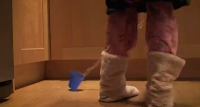In what ways does the media product use,
develop or challenge forms and conventions of real media products?
When it came to planning our short film I
began by looking into various aspects of the construction of a film, in
particular the areas of genre and continuity prior to the commencement of
filming. The aspect of genre was especially relevant because it presents an
opportunity to challenge aspects of real media product. By focusing on
continuity I felt this gave me an opportunity to develop an area which was
lacking in my AS Media Product.
This piece was shot on tape, allowing us
within certain constraint’s to attempt
to produce something that had the feel of shooting on film which was something
we really wished to achieve. One of the ways in which this was developed was by
concentrating on the color editing to overcome the very apparent ‘digital’ look
to my previous work. It is in this area that many films on sites such as
YouTube are disappointing, because of the limitations of the digital equipment used and very often the
lack of a very good storyline and poor production values.
An area we concentrated heavily on was the tempo the storyline. The
decision was made very early to produce a drama. A conscious decision was made
to avoid the often stereotypical look of a student horror film a clichéd genre
which we did not wish to fall into
I terms of the conventions of drama it was our wish to follow as closely
as we could the accepted methods of moving the film forwards, utilizing the
interactions of the characters through their dialogue, supported by the use of
non verbal audio and visual cues. It was our desire to present the audience
with characters to which they felt a sympathetic attachment to enhance their
involvement with the film, thus utilizing one of the traditionally accepted means of the film
genre.
The depressed and unhappy emotional state of Ivy, the main character,
through out, sets the tone of the film.
We used a number of film elements which are classic of the
horror/thriller genre, for example the opening credits, in which Ivy is seen in
fearing for her life. The scene develops tension both visually and with the aid
of non diegetic music as it progresses, leading the audience to also fear
something dreadful is about to happen to her. At the last moment Ivy awakes
safe in her bed, releasing the tension built with in the scene. This is a
classic example often used within the horror/thriller genre, for example the
character Nancy waking in Nightmare on ElmStreet.


The apparent appearance of something that disturbs Ivy one night as she
fills a glass of water would have been enhanced by a slow motion shot of the
glass hitting the floor, we were unable to achieve this due to not having
access to equipment able to shoot at a higher frame rate.
| The character 'Carly' in 2005 House of wax follows this theory and survives the the end of the film |
The conclusion of the film as Ivy realizes that the ‘monster’ that has
been plaguing her nightmares is in fact her sister wishing to say goodbye so
Ivy can accept her passing and release the tension within the audience is
achieved through another dream sequence, or is it?
2.
4. How did you use new media techniques in the construction and research, planning and evaluation stages?

This project allowed the utilisation of a number of new technologies and skills during the pre-production stages to develop and exchange ideas. Social networking sites, Facebook and Skype were invaluable in this process as well as YouTube. This allowed the posting of clips for comment by others as well as critical feedback allowing us to make changes before the final editing took place. As we did during our AS year we used a blog extensively to exhibit both team and individual work which has the additional benefit of allowing us to see how much work needed to be done at a given time.

Even before the start of this year we began research on YouTube and other websites such as BBC Films and Vimeo to look and gather information and examples of short film making to help us develop our project. From the extensive collection of films I watched I gained a wealth of inspiration.

Filming was done using the Sony HDV-1000 video camera. A camera that allowed shooting in 1080i, HD quality footage, which contributed a more professional look to the finished film. A higher quality boom microphone replaced the one that is with the camera. Lighting came from units from the College, and from my father who works in Archaeology at the University of Sheffield Some of this was in fact too bright for certain scenes. The use of a steadicam allowed for smoother tracking shots. Positive feedback was received from people via YouTube and teachers at college. Some of the steadicam shots did not turn out quite as well as we hoped but some did make it into the final cut.
When filming was complete we returned to the classroom for editing using Final Cut Express software installed on iMac computers at the college. My skills had developed since last year and I have become accustomed to the software and during the course of using it this year. I have used other editing software at home which helped in this process. Audio editing was undertaken using Logic Pro 9 and MIDI sequencing software by Ben. For my posters I drew out images and painted them by hand after which they were scanned into the computer These were manipulated using Adobe Photoshop to produce the final graphic images. I was sad that I did not have access to equipment that worked for me, so I could have made my poster much more professional and high quality, but I feel as though the theme comes through and it works for the plot.
2.
4. How did you use new media techniques in the construction and research, planning and evaluation stages?

Even before the start of this year we began research on YouTube and other websites such as BBC Films and Vimeo to look and gather information and examples of short film making to help us develop our project. From the extensive collection of films I watched I gained a wealth of inspiration.
Filming was done using the Sony HDV-1000 video camera. A camera that allowed shooting in 1080i, HD quality footage, which contributed a more professional look to the finished film. A higher quality boom microphone replaced the one that is with the camera. Lighting came from units from the College, and from my father who works in Archaeology at the University of Sheffield Some of this was in fact too bright for certain scenes. The use of a steadicam allowed for smoother tracking shots. Positive feedback was received from people via YouTube and teachers at college. Some of the steadicam shots did not turn out quite as well as we hoped but some did make it into the final cut.


No comments:
Post a Comment